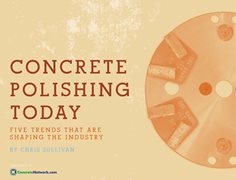- Concrete Polishing Equipment
- Get the Look - Polished Concrete Pictures
- How to Polish Concrete: Learn the basics and get a step-by-step overview
- Polished Concrete Preparation: How to clean, repair, and evaluate before polishing
- Concrete Polishing vs. Resurfacing
- Reviews of Concrete Polishing Equipment How to clean, repair, and evaluate the condition of concrete floors before polishing
- Tips on Using Polishing and Grinding Equipment
- Tips for Choosing Edge Grinders
- Selecting Dust-Collection Equipment
- Diamond Tooling: Tips for choosing the right type of diamond tooling and equipment
- Concrete Densifiers: An introduction to chemical hardeners and how they work to improve polished concrete
- 2023 Polishing Techniques: An online interview series featuring Bob Harris
New Developments in Concrete Polishing Equipment
Today’s concrete polishing equipment offers greater versatility than ever before, accommodating projects of various sizes and budgetsThis is an excerpt from the new e-book “Concrete Polishing Today,” part of a series of reports from ConcreteNetwork.com on trends and insights about decorative concrete applications.
Concrete Polishing Today

Discover five developing trends in concrete polishing from ConcreteNetwork.com’s new e-book. You’ll also get insights and guidance from veteran polishers that will help you stay profitable in today’s market.
Download Concrete Polishing Today (PDF)
The polished concrete industry has come a long way in the last 10 years, offering more equipment options to accommodate various job demands and budgets. Chris Raiser, manager of Extreme Polishing, a distribution outlet in Deerfield Beach, Fla., deals with many different installers, all running different brands and sizes of polishing equipment. He sees a lot of companies starting out with small machines because they cost less and are a great way to enter the industry. As the company grows and the size of the jobs they take on gets bigger, they replace the smaller models with larger equipment and use the small machines for doing edges and working work in tight spaces.
According to Brad Walker, owner of Lone Star Decorative Concrete, Watauga, Texas, the weight of the machine is very important when polishing, especially on hard, dense concrete. It can make a big difference in how many hours are spent on the floor, which translates to less labor and reduced wear and tear on the machine. “We get 2,500 hours of working time from our machines before we need to do any major maintenance of repair work,” he says.
Although electric polishing equipment still dominates the industry, some installers are trending toward propane-powered polishers. “The main selling point of the propane unit is that you do not have to fight with power cords,” says Bob Harris, owner of The Decorative Concrete Institute, Temple, Ga. Another selling point is that you don’t need the external generators often required to run larger electric-powered machines. Although propane-powered equipment does not have cords or generators, they can produce harmful emissions when operated inside buildings with poor ventilation. Propane machines can also be louder and require more maintenance than electric polishers.
The package approachAnother factor important to installers is how easy the equipment is to operate. Abner Peachey, sales manager for Rosebud Concrete, Myerstown, Penn., whose company uses HTC machines, says the equipment seems to be getting more user-friendly. They run their HTC 500 and 800 series machines along with HTC tooling. “We see an advantage to running the same equipment and tooling,” he says.
Harris also sees the benefits of using equipment from a manufacturer who offers a complete package. “The reality of the equipment side of the business boils down to what kind of complete package does the manufacturer have to offer,” he says.
Harris recommends matching your equipment to the size of the job. A common mistake for companies new to polishing is that they do not have the right number or size of polishing equipment for the job at hand. “In other words, don’t attack a floor with a machine that has a grinding width of 20 inches on 60,000-square-foot project,” he says.
The service and training offered by the manufacturer after the sale are also important. Many companies offer these services, but they are not all the same. Be sure to do your homework before making a purchase, especially of big-ticket equipment.
New edge grinding optionsAlthough large machines work well in open spaces, they don’t work well along edges against existing walls, leaving anywhere from a few inches to almost a foot that need to be polished by hand or with a smaller machine. “The two main ways we address edges, short of making them decorative, is the old traditional way -- which is on your hands and knees with hand-held edge grinders -- or the less backbreaking way using the HTC 270 walk-behind edge grinder,” says Harris.
The old-school method of working on your hands and knees is giving way to advances in smaller machines that operate standing up. Walker says that they used to charge extra for edge work because it was so tedious and labor intensive. Now it’s just part of the job because they have more efficient equipment.
How you tackle edges has become more about working smarter than harder. “It boils down to the configuration of the rooms and how much straight wall there is as to why we would use one method [hand held vs. upright machine] over the other. More often than not, we use a combination of both methods,” says Harris.
Related informationFind suppliers of concrete polishing equipment
Return to Concrete Polishing Today
 Polishing Diamonds
Options for hard, medium, and soft concrete.
Polishing Diamonds
Options for hard, medium, and soft concrete.
 Propane Concrete Polisher
Concrete Polishing HQ
Propane Concrete Polisher
Concrete Polishing HQ
 Lythic Densifier XL
1 Gallon & 5 Gallon sizes
Lythic Densifier XL
1 Gallon & 5 Gallon sizes




